CTR的应用场景
CTR主要应用在广告系统和推荐系统当中,其目的在于预估出用户点击相应广告/推荐物品的概率。
CTR在推荐系统中的应用方式主要有两种:
- 推荐列表依据 \( CTR \) 的值进行排序
- 推荐列表依据 \( CTR*bid \) 的值进行排序( \(bid\)是指如果用户点击该推荐,商家可以获得的收益)
CTR在广告系统中的应用也是类似,平台会根据广告收益和CTR的值对广告进行排序。
CTR的难点
-
难以发掘有效的交叉特征:
-
高阶特征本身发掘难度较大,只能通过ML学习
-
低阶特征在特征维度较多时同样难以发现
-
现有方法的研究方向
-
更充分的提取低阶和高阶交叉特征;
-
自动提取交叉特征,很多线性模型依然需要大量的专业业务领域的知识进行人工构造;
提取交叉特征的方法
- FM
- Ploylearn
- DNN
- GBDT
CTR的主流技术
- Factorization machine1, 2010
FM(Factorization Machine)是由Konstanz大学Steffen Rendle(现任职于Google)于2010年最早提出的,旨在解决稀疏数据下的自动特征组合问题。
Code: Sklearn实现了FM和ploylearn(另外一种提取低阶特征的方法) https://github.com/scikit-learn-contrib/polylearn FastFMlib: https://github.com/ibayer/fastFM 作者Rendle在2012年用C++实现了LibFM,并发表论文2
- Field-aware Factorization Machine, 2012
FFM最初的概念来自Yu-Chin Juan(阮毓钦,毕业于中国台湾大学,现在美国Criteo工作)与其比赛队员,是他们借鉴了来自Michael Jahrer的论文3中的field概念提出了FM的升级版模型。通过引入field的概念,FFM把相同性质的特征归于同一个field。
Code 台大‘3idiots’用GBDT+FFM赢了criteo: https://github.com/guestwalk/kaggle-2014-criteo 台大’4idiots’(+MJ)用FFM赢了avazu: https://github.com/guestwalk/kaggle-avazu
- Follow the Regularied Leader, 2013
FTRL是一种基于逻辑回归的在线学习算法,能够学习出有效且稀疏的模型。FTRL 是由 Google 的 H. Brendan McMahan 在 2010 年提出的 4 ,2013 年又和 Gary Holt, D. Sculley, Michael Young 等人发表了一篇关于 FTRL 工程化实现的论文 5 。 FTRL 算法融合了 RDA 算法能产生稀疏模型的特性和 SGD 算法能产生更有效模型的特性。它在处理诸如 LR 之类的带非光滑正则化项(例如 1 范数,做模型复杂度控制和稀疏化)的凸优化问题上性能非常出色,国内各大互联网公司都已将该算法应用到实际产品中。
Code: python版: https://github.com/fmfn/FTRLp 多线程版: https://github.com/bingzhengwei/ftrl_proximal_lr
- GBDT + LR, 2014
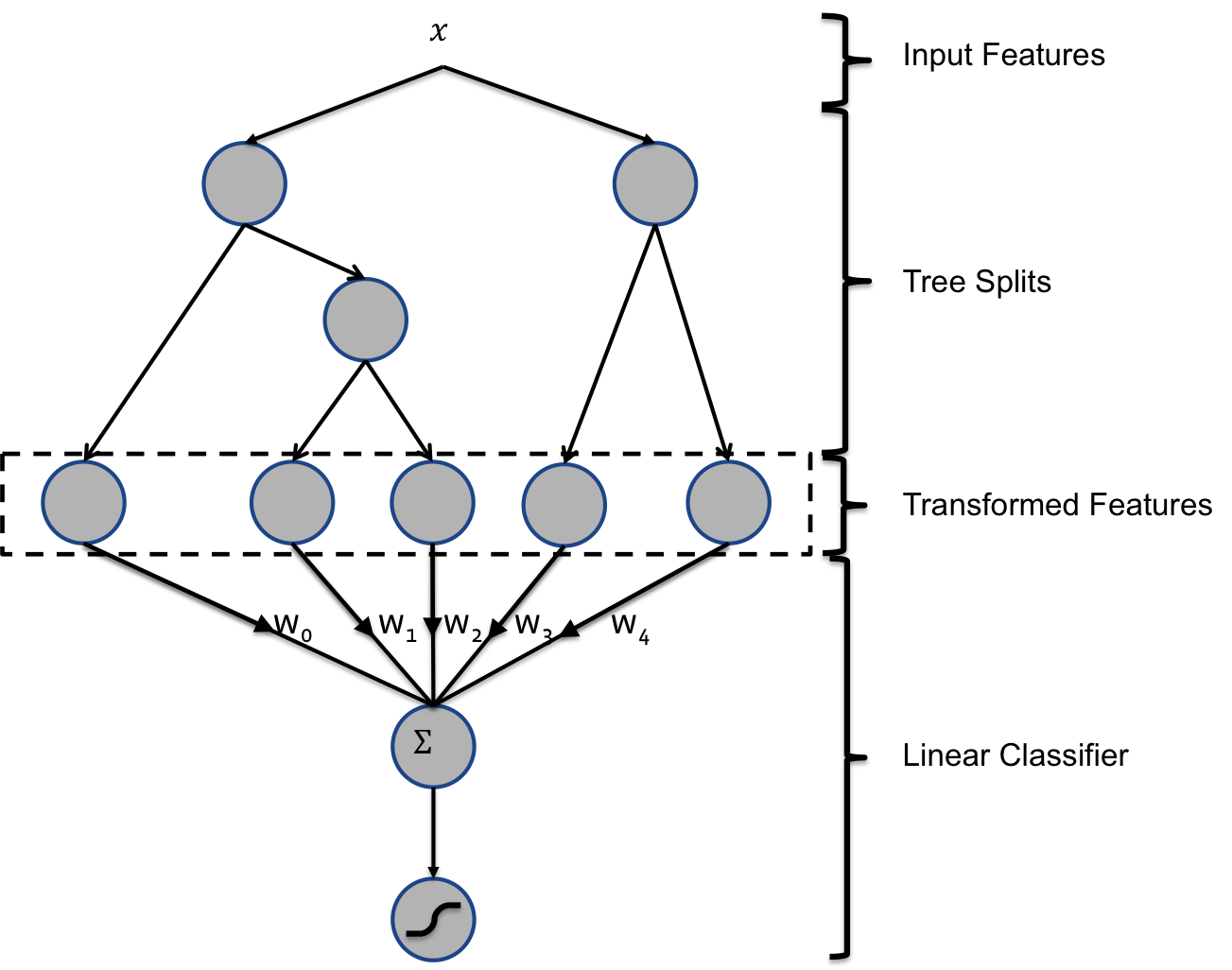
2014 年 Facebook 发表了一篇在 CTR 领域极具影响力的论文 6 ,该论文尝试提出一种解决特征组合问题的方案,基本思路是利用树模型的组合特性来自动做特征组合,结合 GBDT 训练出一些组合特征,然后再传入 LR 进行分类,该方法取得极大成功,但也有很大程度的过拟合风险,所以必须要采取相应的防止过拟合的措施。
evaluation: AUC/NE(Normalized Entropy)/calibration(the ratio of the average estimated CTR and empirical CTR)
Code: https://github.com/neal668/LightGBM-GBDT-LR
- RNN(2014)
更倾向于序列数据7
evaluation: AUC/RIG compare with LR / NN
Code: https://github.com/neal668/LightGBM-GBDT-LR
- CNN(2015)8
更倾向于由相邻特征之间的相互作用而产生的交叉特征.
dataset: avazu: https://www.kaggle.com/c/avazu-ctr-prediction/data Yoochoose: http://recsys.yoochoose.net
evaluation: logloss compare with LR / FM / RNN
Code: https://github.com/neal668/LightGBM-GBDT-LR
- Wide & Deep model(2016):
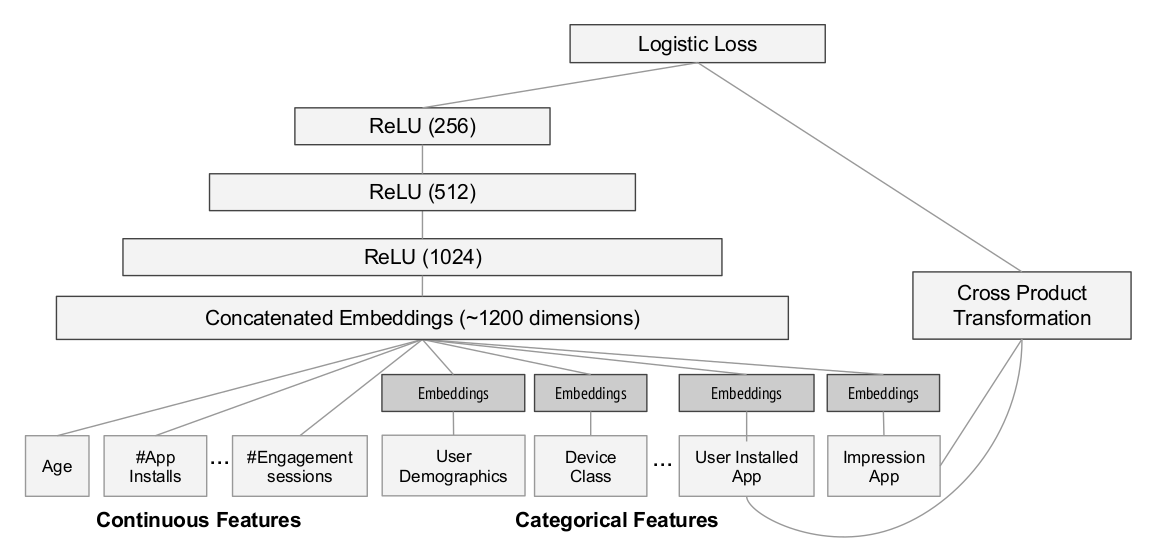
是 2016 年 Google 开源于 TensorFlow 的一种混合网络结构 9 ,包括 wide 和 deep 两部分,其中 wide 是一个线性模型,deep 是一个深度模型, 两部分所需的输入不同,wide 依然需要预先的特征工程, 而 deep 部分不需要;其主要缺 陷就在于 wide 部分依然需要依赖预先的特征工程;
dataset: Google Play game center
evaluation: AUC / online test compare with wide / deep / wide & deep
Code: wide & deep model: https://www.tensorflow.org/tutorials/wide_and_deep
- Factorization-machine supported Neural Network(FNN10, 2016)
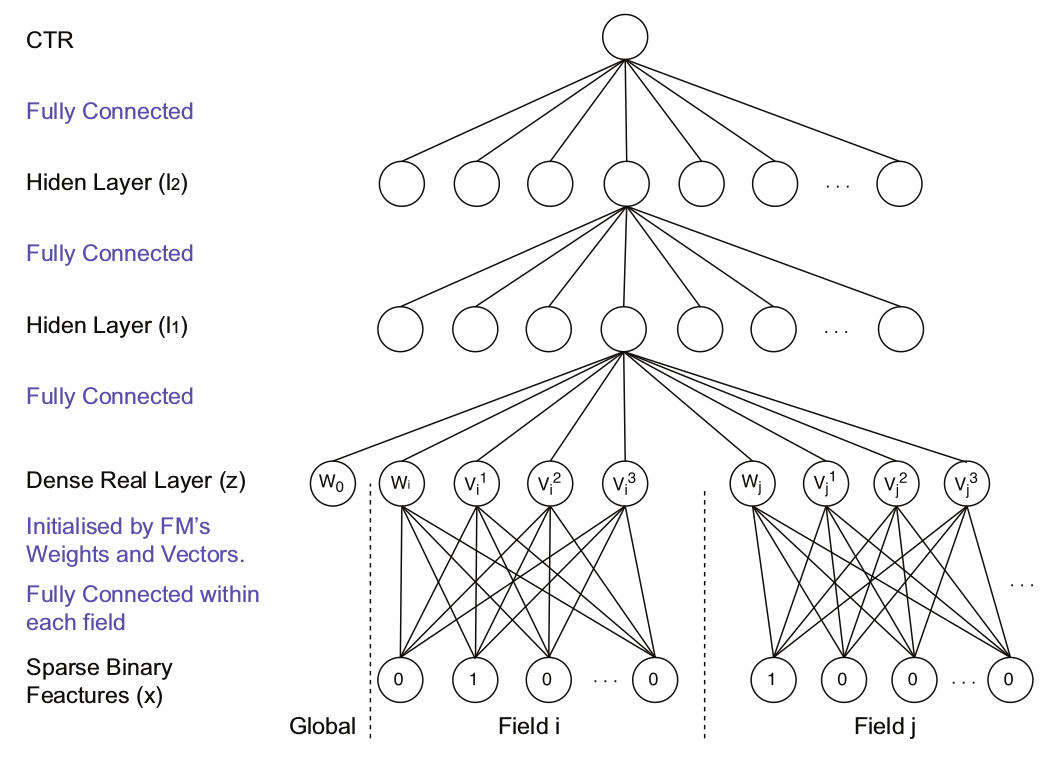
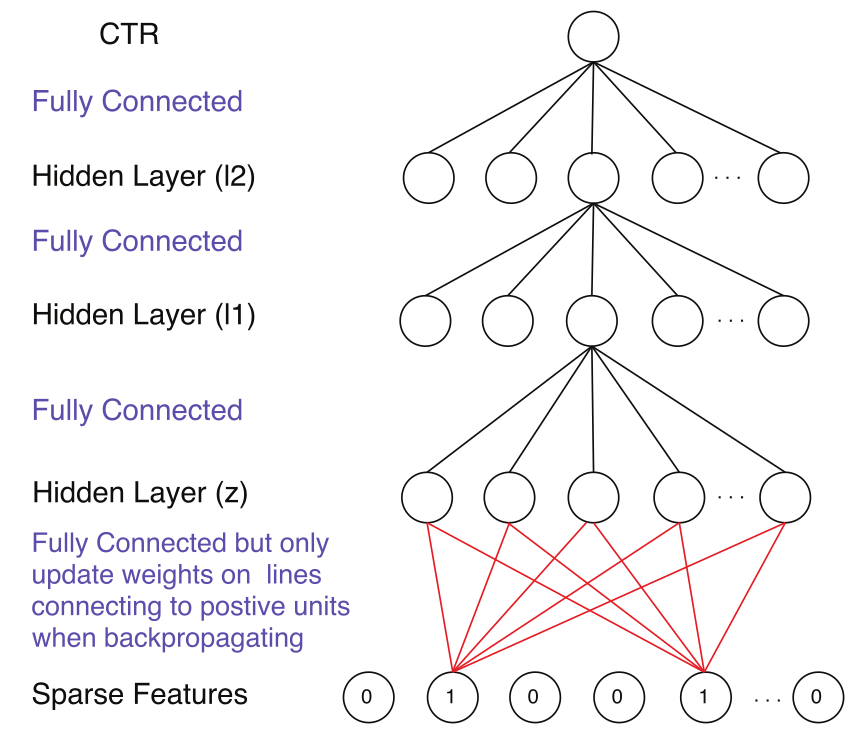
FNN 先训练 FM,然后以 FM 训练的参数对 DNN 进行初始化,继而训练 DNN 模型,该方法的缺陷在于后续 DNN 的训练可能会覆盖掉第一步 FM的预训练成果,从而导致低阶交叉特征的学习能力较差。
dataset: iPinYou: 19.5M instances(14.79k positive), 937.67K features,
evaluation: AUC compare with LR/FM/FNN/SNN*
Code: FNN&SNN: https://github.com/wnzhang/deep-ctr
- Product-based Neural Network(PNN, 2016)
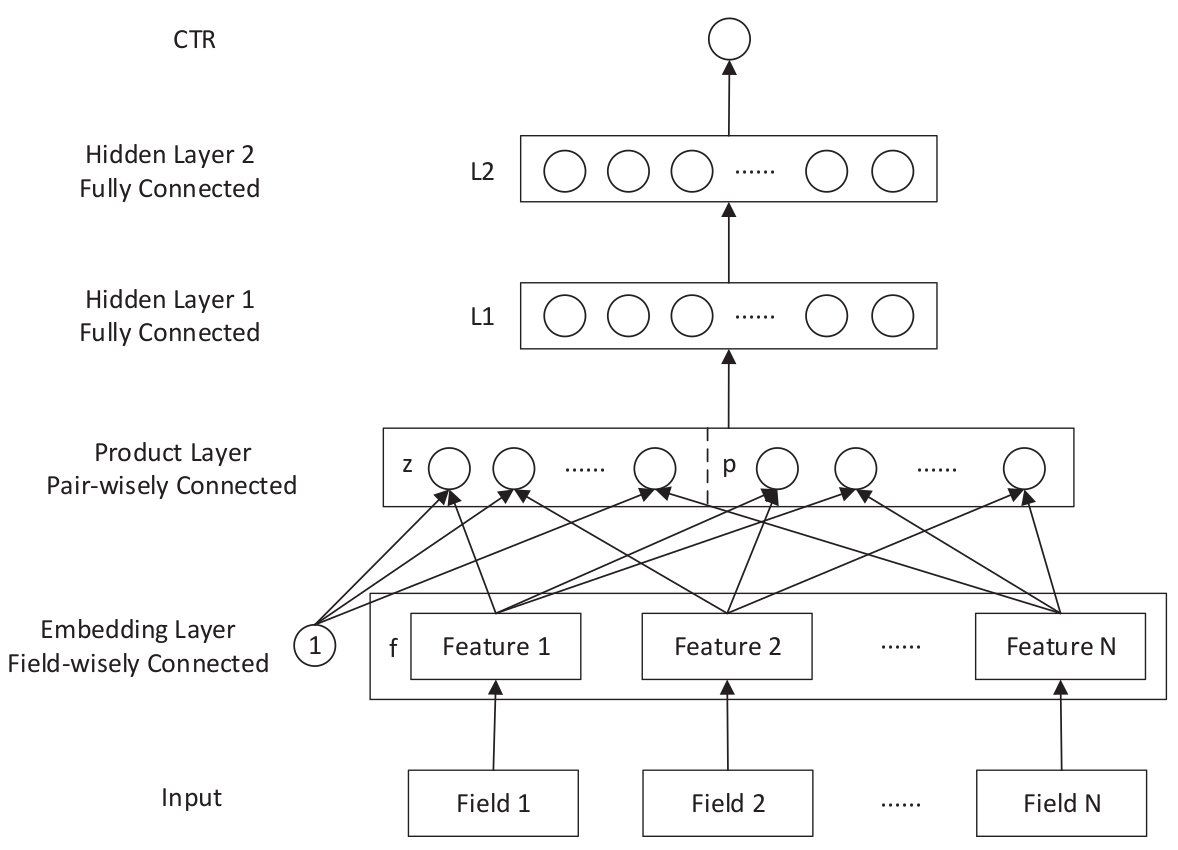
PNN(Product based Neural Network)是由上海交通大学的 YaYanru Qu 和伦敦大学的Ying Wen 等人发表的论文 11 中提出的, PNN 在 DNN 的基础之上作出改进,在 embeddinglayer 和 fully connected layer 之间增加了一个 product layer,使 PNN 具备高阶交叉特征的学习能力。
dataset: criteo: 1T数据,选取7天训练,1天测试(79.38M instances, 1.64M features) iPinYou: 19.5M instances, 937.67M features, 一共10天数据,7/3分
evaluation: AUC & RIG compare with LR/FM/FNN/CCPM/IPNN/OPNN/PNN*
Code: PNN: https://github.com/Atomu2014/product-nets
- Deep Factorization Machine(2017)
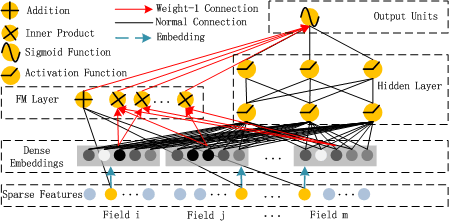
DeepFM12是2017年华为诺亚方舟实验室提出的一种新的FM+DNN模型,该模型主要分为deep和wide两部分,deep模块使用deep learning学习高阶交叉特征,wide模块使用FM提取低阶交叉特征,deep和wide两个模块共享输入和embeddings,最终通过output layer进行结合,输出CTR。
dataset: Criteo(4.5million records, 13连续特征, 26离散特征), 9:1划分; Company(1 billion, 7天训练, 1天测试)
evaluation: AUC & Logloss compare with LR/FM/FNN/PNN/WDL/DeepFM
Code: DeepFM/CCFNet/BMF: https://github.com/Leavingseason/OpenLearning4DeepRecsys
- Neural Factorization Machines(2017)
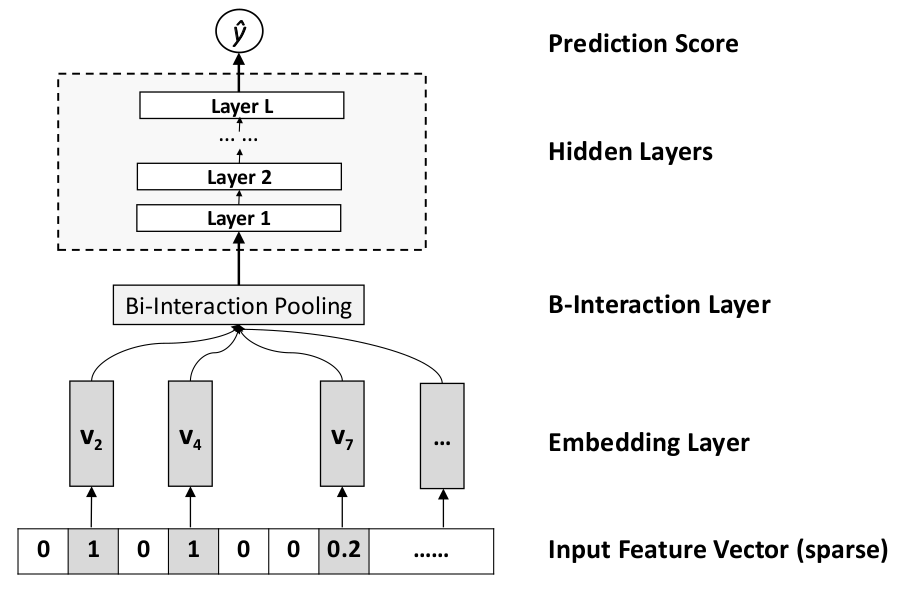
NFM 13是一种新型的DNN,其本质是用DNN实现的更高阶的FM,从而增强了其非线性表达能力。 dataset: Frappe: (288609 instances, 5382 features); MovieLens: (2006859 instances, 90445 features) train: validation:test 9:2:1 evaluation: RMSE compare with FM/High order FM/Wide&Deep/DeepCross
- Attention Factorization Machines(2017)
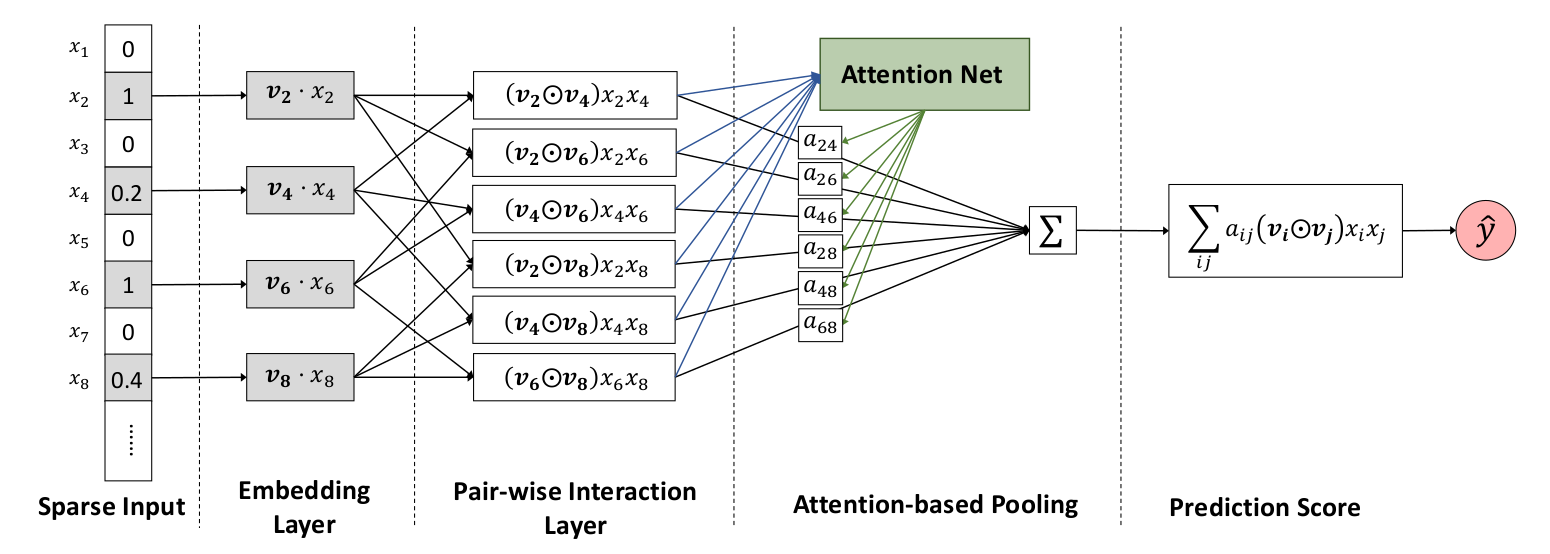
AFM模型14是NFM的一种改进模型。在传统FM模型中,使用二阶交叉特征得到非线性表达能力,但是不是所有的特征交叉都会有预测能力,很多无用的特征交叉加入后反而会相当于加入了噪声,因此,在AFM模型中,加入了Attention Net机制,旨在去降低噪声特征的干扰。
dataset: Frappe: (288609 instances, 5382 features); MovieLens: (2006859 instances, 90445 features) train: validation:test 9:2:1 evaluation: RMSE compare with FM/High order FM/Wide&Deep/DeepCross
CT预测总体流程
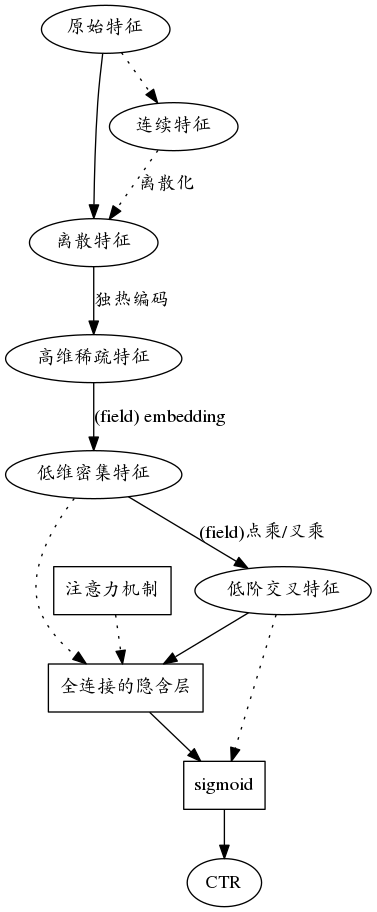
通常, CTR预测包括如下流程:
-
特征预处理
-
连续特征标准化
-
连续特征离散化(离散特征更易于提取交叉特征)
-
离散特征二值化
-
-
embedding layer
- 借鉴FM/FFM的思路,将每个feature/field转化为embedding向量(降维同时变稀疏为密集)
- 或者 hash trick(FFM), 但是这种方法,没有embedding的密集优势
-
feature interaction 仅仅是原始特征很难达到好的效果,所以需要挖掘交叉特征,常见的挖掘交叉特征的方法包括:
- FM
- FFM
- GBDT(可以学习到高阶交叉,但缺陷在于不能joint training)
- Product layer(inner product / outer product)(这里可以借鉴FFM的思路)
-
hidden layer 鉴于神经网络强悍的特征表示能力,一般都会在最后加几层全连接层学习难以挖掘的高阶交叉特征
- 可以添加 attention net
- 抑制过拟合,可以结合SNN的dropout?或者early stopping?
- 选择合适的optimizer
-
output layer output layer一般都是sigmoid function
参考文献
-
Rendle, Steffen. “Factorization machines with libfm.” ACM Transactions on Intelligent Systems and Technology (TIST) 3.3 (2012): 57. ↩
-
Steffen Rendle (2012): Factorization Machines with libFM, in ACM Trans. Intell. Syst. Technol., 3(3), May. ↩
-
Jahrer, Michael, et al. “Ensemble of collaborative filtering and feature engineered models for click through rate prediction.” KDDCup Workshop. 2012. ↩
-
MCMAHAN H B, STREETER M. Adaptive bound optimization for online convex opti-mization[J]. arXiv preprint arXiv:1002.4908, 2010. ↩
-
MCMAHAN H B, HOLT G, SCULLEY D, et al. Ad click prediction: a view from thetrenches[C] // Proceedings of the 19th ACM SIGKDD international conference on Knowl-edge discovery and data mining. 2013 : 1222 – 1230. ↩
-
HE X, PAN J, JIN O, et al. Practical lessons from predicting clicks on ads at facebook[C]// Proceedings of the Eighth International Workshop on Data Mining for Online Advertising.2014 : 1 – 9. ↩
-
Zhang, Yuyu, et al. “Sequential Click Prediction for Sponsored Search with Recurrent Neural Networks.” AAAI. 2014. ↩
-
Liu, Qiang, et al. “A convolutional click prediction model.” Proceedings of the 24th ACM International on Conference on Information and Knowledge Management. ACM, 2015. ↩
-
CHENG H-T, KOC L, HARMSEN J, et al. Wide & deep learning for recommender sys-tems[C] // Proceedings of the 1st Workshop on Deep Learning for Recommender Systems. 2016 : 7 – 10. ↩
-
ZHANG W, DU T, WANG J. Deep learning over multi-field categorical data[C] // Europeanconference on information retrieval. 2016 : 45 – 57. ↩
-
QU Y, CAI H, REN K, et al. Product-based neural networks for user response prediction[C]// Data Mining (ICDM), 2016 IEEE 16th International Conference on. 2016 : 1149 – 1154. ↩
-
GUO H, TANG R, YE Y, et al. DeepFM: A Factorization-Machine based Neural Networkfor CTR Prediction[J]. arXiv preprint arXiv:1703.04247, 2017. ↩
-
HE X, CHUA T-S. Neural Factorization Machines for Sparse Predictive Analytics[J], 2017. ↩
-
XIAO J, YE H, HE X, et al. Attentional factorization machines: Learning the weight of feature interactions via attention networks[J]. arXiv preprint arXiv:1708.04617, 2017. ↩
